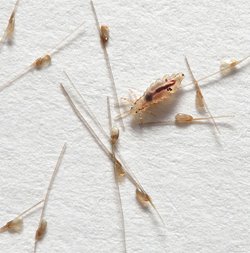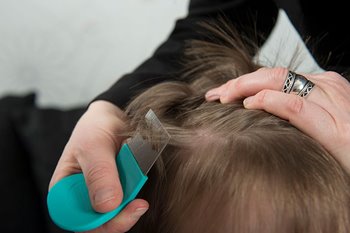 The coronavirus may be making all of the headlines this year, but as children head back to school, it’s important to remember that other health issues that specifically affect children will remain. Even in 2020, head lice will continue to affect school children nationwide. In fact, in any given year, it is estimated that 6 to 12 million head lice infestations occur in the United States, primarily in children between the ages of 3 and 11.
The coronavirus may be making all of the headlines this year, but as children head back to school, it’s important to remember that other health issues that specifically affect children will remain. Even in 2020, head lice will continue to affect school children nationwide. In fact, in any given year, it is estimated that 6 to 12 million head lice infestations occur in the United States, primarily in children between the ages of 3 and 11.
In order to better understand these pesky parasites, as well as to dispel some of the stigma that accompanies a head lice infestation, we decided to take a closer look at what head lice are, how they spread, and how they are treated.
What are lice?
 A louse is a very small, parasitic insect that feeds on human blood several times a day. All lice have three forms:
A louse is a very small, parasitic insect that feeds on human blood several times a day. All lice have three forms:
- Nit/egg – Lice eggs are extremely small, to the point of being hard to see, and on average take 6 to 10 days to hatch.
- Nymph – The newly hatched and immature louse looks like an adult louse, but is smaller. It takes between 6 to 9 days for a nymph to mature into an adult louse, capable of laying eggs.
- Adult – Fully grown, an adult louse is still quite small—about the size of a sesame seed. The adult head louse is medium-sized (2.1-3.3 mm), and is tan or light-gray in color.
How do head lice spread?
All lice spread through close contact between people. Lice cannot fly, and, unlike fleas, cannot hop. Instead, lice crawl from one person to another, which means direct contact is required. Head lice, specifically, are most commonly spread by:
- Pre-school age children who attend day care
- Elementary school children
- Family or household members of infested children
Because head lice cannot hop or fly, they spread by crawling from the head of one child to another. This means that in order for a transmission to occur, close head-to-head contact is generally required.
Once transmission occurs, the adult louse will use the claws at the end of its legs to hold onto the hair. It will then crawl to the base of the hair shaft and lay its eggs next to the scalp. These eggs, or nits, are cemented to the hair and cannot move. This means that nits do not spread head lice. Rather, transmission requires nymphs or adult lice.
Common misconceptions
Frequently held beliefs about head lice are often incorrect or associated with body lice. For example:
- Head lice do not spread disease. While body lice are known to spread bloodborne pathogens like typhus, thankfully, head lice have not been found to transmit disease.
- Head lice are not caused by poor hygiene. Body lice spread in unsanitary conditions because they live on unwashed clothing. However, because normal soaps and shampoos will not affect head lice or the spread of head lice, no amount of bathing will prevent the spread of head lice. Head lice can spread regardless of how clean a school or home is.
- Head lice are not spread by dogs, cats or other household pets. Unlike fleas and ticks, pets cannot spread lice. There is over 3000 species of lice, and they are largely species specific. Human lice require human blood to survive.
How do I know if my child has head lice?
The Centers for Disease Control and Prevention (CDC) outline four common signs and symptoms of head lice, which include:
- A tickling feeling, or the feeling of movement in the hair.
- Itching, which is caused by an allergic reaction to head lice bites.
- Difficulty sleeping, because head lice are most active at night.
- Sores on the scalp from scratching. Be aware: sores caused by scratching head lice bites can become infected with the bacteria that exist on a person’s skin.
Diagnosis—how do I know if my child has lice?
If your child has any of the symptoms described above, it may be time to figure out if they have head lice, which is generally done by finding a live nymph or adult louse in your child’s hair.
 Determining if your child has head lice can be difficult. Remember, lice are extremely small (the size of a sesame seed). They also avoid the light and can move very quickly. If you suspect that your child has head lice, the CDC suggests using a magnifying glass and a comb to search through your child’s hair for “crawling”—that is, living—nymphs or adult lice.
Determining if your child has head lice can be difficult. Remember, lice are extremely small (the size of a sesame seed). They also avoid the light and can move very quickly. If you suspect that your child has head lice, the CDC suggests using a magnifying glass and a comb to search through your child’s hair for “crawling”—that is, living—nymphs or adult lice.
If no crawling head lice can be found, look for nits. However, finding nits is even more difficult than finding nymphs or adult lice. In fact, nits are so small that they are often mistaken for dandruff.
When looking for nits, remember that they will be cemented onto the hair shaft. Also, look for nits that are less than ¼ inch from the scalp. This has to do with hair growth. Lice lay their eggs at the base of hair shaft, next to the scalp. As mentioned earlier, it takes 6 to 10 days for the nits to hatch. In that time, the hair will have grown about ¼ inch. If the eggs are more than ¼ inch from the scalp, they will have already hatched, and you should be looking for nymphs or adult lice.
If your child is displaying the signs and symptoms of head lice, but you cannot find them or their nits, contact a trained healthcare professional—public health, a school nurse or your pediatrician—for a diagnosis.
Treatment options—what medicines will get rid of lice?
Shaving a child’s head to get rid of lice is a thing of the past. Nowadays, there are several, effective medications that can kill head lice called pediculicides. These medications are normally topical, and are applied as a shampoo. Some are ovicidal—that is, they kill the nits as well as the nymphs and adult lice—but most are not. Non-ovicidal medications, which do not kill nits, normally require a second treatment 9 to 10 days after the first treatment in order to kill any lice that may have hatched after the first treatment.
Over-the-counter medications:
- Pyrethrins are derived from the chrysanthemum flower. These are non-ovicidal and require a second treatment. Pyrethrins are approved for children 2 years and older. Pyrethrins should not be used by anyone that is allergic to chrysanthemums or ragweed. Common brand names: A-200, Pronto, R&C, Rid and Triple X.
- Permethrin lotion, 1%, is non-ovicidal, requires a second treatment, is hypoallergenic, and is approved for children 2 months or older. Brand name: Nix.
If head lice prove to be resistant to the over-the-counter medication, a number of prescription pediculicides are available and it is recommended that you contact your child’s pediatrician to discuss your options.
Prevention and control—stopping the spread
Once your child has been treated for head lice, additional steps can be taken to prevent the spread of lice to other family or household members. Head lice can only live for a very short time—1 to 2 days—if they have fallen off a person and cannot feed. As a result, it is less common (but not uncommon) for head lice to spread by sharing articles of clothing or by sitting on furniture that a louse has fallen onto. The CDC recommends taking additional steps if someone in your house has recently been treated for lice.
Additional steps include:
- Do not share hats, scarves, coats, sports uniforms, hair ties or barrettes with other members of the family
- Additionally, do not share brushes, combs or towels. You can disinfect brushes and combs by soaking them in hot water (at least 130° F) for 5 to 10 minutes.
- Using the hot setting, machine wash, clothing, bed linens and other items the infested person may have been wearing or used 2 days prior to treatment.
- Vacuum the floor and furniture.
- Do not use fumigant sprays or fogs. These products will not kill lice and can be toxic.
•
While some may find a head lice infestation embarrassing, today they are not a serious health concern, but rather an irritation and inconvenience. If you suspect your child has been exposed to head lice and may need treatment, please consider contacting you child’s school nurse or public health at for help with a diagnosis, or contact Door County Medical Center at 920-743-5566 and ask for the Children’s Center to talk about your treatment options with a childcare provider. For additional and detailed information regarding head lice symptoms, treatment and prevention, please visit the Center for Disease Control and Prevention’s website at: https://www.cdc.gov/parasites/lice/head/index.html.